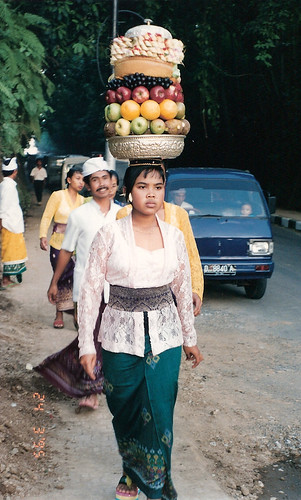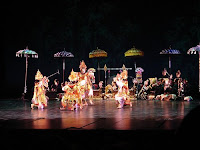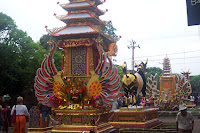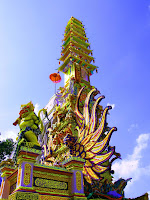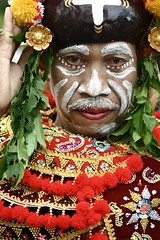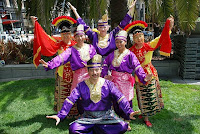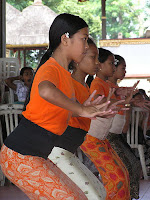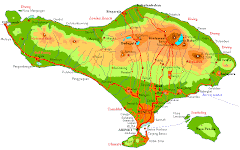The Ubud Royal Cremation yesterday, July 15, 2008, was unbelievable. The towers were like a 10 story building, and carried by 100 or so guys, sometimes moving very fast. They had to cut down some trees beside the road and all the telephone wires were down for a few hours to allow the towers to pass. The procession started at the Ubud royal palace and traveled down the main road about 1/2 mile to the Royal Cemetery. There were ramps built at both ends to load the bodies into and out of the towers some 30 feet off the ground.
There were mobs of people--I went to the cremation ground early to try to get a good spot from which to video, but all efforts were rather futile once the throngs arrived and jockeyed for sight lines. I was often holding my camera overhead using the tripod. I had a good view of the front of the procession of the immediate family members, with two younger members dressed really finely in traditional costume and carried in palanquins.
When the towers arrived, there was a swelling of excitement in the crowd. It was so impressive to see these massive things move, you almost couldn't believe what you were seeing--like some sci-fi movie of a giant walking down the street. Bearers climbed up the ramp to bring the bodies down. There were two elegant caskets, probably TJOKORDA GDE AGUNG SUYASA, head of the Ubud Royal Family and the leader of the traditional community in Ubud since 1976 and TJOKORDA GEDE RAKA, a senior officer in the police force in Denpasar until his retirement in 1992. One person was in a plain white cloth. Perhaps this was the effigy of GUNG NIANG RAKA.
The bearers held the three bodies overhead for more than an hour while the bull sarcophagi were positioned on the cremation platform. The space was tight and there were so many people it was like threading a needle with these huge unwieldy sculptures.
Everyone, not least of which, the purple-shirted bearers, cheered loudly when they finally placed the second bull on the platform. The backs of the bulls were cut open to place the bodies inside.
The MC asked everyone to sit for the sacred ceremony, which none of us could really see or hear, but took about another hour. I did see some offerings and beautiful cloths being carefully placed on top of the deceased and heard faint singing or chanting from the platform. Some family members said final farewells from scaffolding placed adjacent to the bull openings. One man came down and was very distraught, but was immediately surrounded by others to comfort and shield him from the hundreds of cameras. Finally the top of the bull was re-attached enclosing the bodies.
The family which led the procession reemerged from the pavilion and circumambulated the cremation platform several times with offerings. Meanwhile a warrior dance was performed with live gamelan, crowds surrounding and almost moving with the spear-weilding dancers. Suddenly the naga serpent appeared, as if swimming through the sea of people, and danced around a little before it too was placed on the platform between the two bulls.
It was now almost completely dark. You could see people loading kindling and chopped firewood beneath the bulls. Then the fire was lit. It started as a small glow, then quickly grew into a roaring fire with red ashes soaring up. Hundreds of camera flashes added to the light show. I was standing about 50 yards away and could feel the heat of the fire. It was strangely comforting, not too hot or smokey as I feared it might be. The heavens seemed to be drawing all the smoke and fire upwards and away. It was stunningly beautiful. You could still make out the beautiful bulls' heads almost the whole time, at one point they seemed to be spewing steam from their mouths. Eventually both heads fell over.
As soon as the fire seemed a little out of control the fire truck waiting nearby sprung into action, spraying down areas that might pose danger to the crowds around. It was amazing to watch them control the blaze, alternately fueling it with fire accelerant hoses and diminishing it with water. It was the most finely orchestrated planned mayhem I have ever witnessed. It surely cost the royal family a mint, and one wonders how long they will be able to keep up with cremation costs, as the cost of living in Bali has greatly increased in recent years.
We had been standing for about 12 hours with little water a no food. We were completely spent, but certainly we were nowhere near as tired as any one of the participants, from the royal family members who have been sitting vigil for months, making offerings, taking care of volunteers, and visitors; to the scores of vounteer bearers, whose back-breaking work was in some ways the most moving contribution to the event. Surely they could more easily load the towers onto large trucks, like the Macy's Parade, but this would make absolutely no sense in this context, where personal effort must be expended to make the whole thing work. To show the deceased how much they were loved in life, and how much they are and will continue to be honored in death.
I have yet to download pictures, but when I do, I will post them. Please check back for some images and video footage.
--posted from Marco Polo Business Center internet cafe in Ubud

















